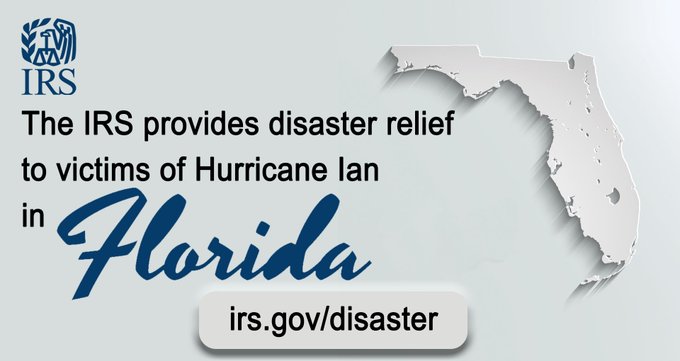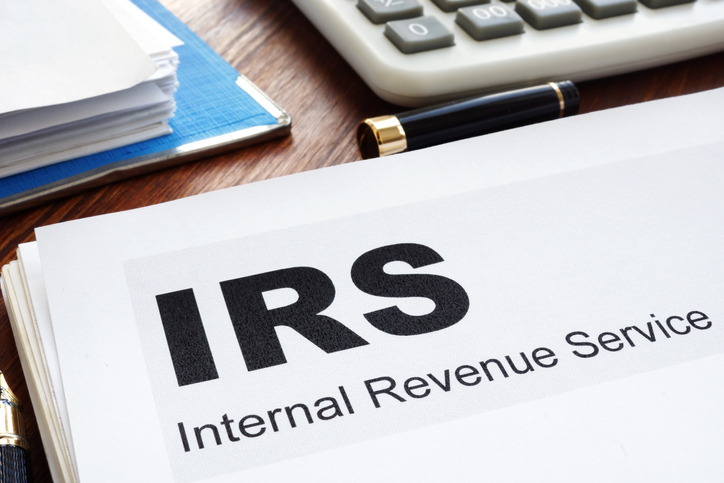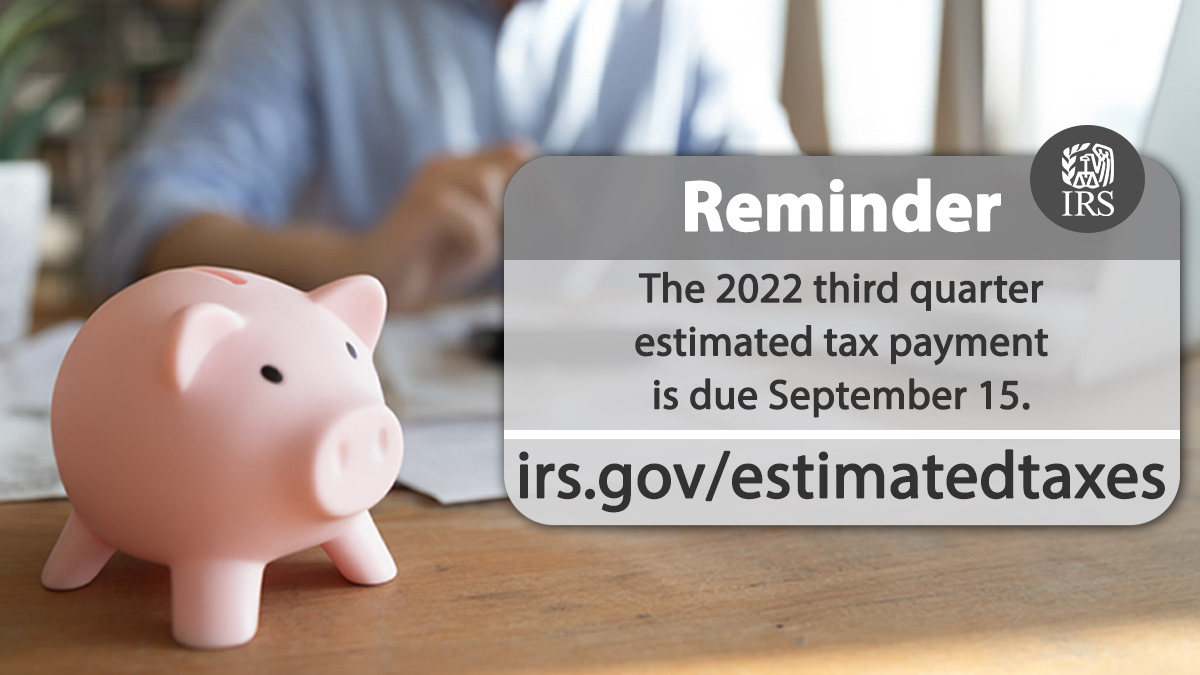FL-2022-19, September 29, 2022
WASHINGTON — Victims of Hurricane Ian that began September 23 in Florida now have until February 15, 2023, to file various individual and business tax returns and make tax payments, the Internal Revenue Service announced today.
Following the recent disaster declaration issued by the Federal Emergency Management Agency, the IRS announced today that affected taxpayers in certain areas will receive tax relief.
Individuals and households affected by Hurricane Ian that reside or have a business anywhere in the state of Florida qualify for tax relief. The declaration permits the IRS to postpone certain tax-filing and tax-payment deadlines for taxpayers who reside or have a business in the disaster area. For instance, certain deadlines falling on or after September 23, 2022, and before February 15, 2023, are postponed through February 15, 2023.
This means individuals who had a valid extension to file their 2021 return due to run out on October 17, 2022, will now have until February 15, 2023, to file. The IRS noted, however, that because tax payments related to these 2021 returns were due on April 18, 2022, those payments are not eligible for this relief.
The February 15, 2023, deadline applies to the quarterly estimated tax payments, normally due on January 17, 2023 and to the quarterly payroll and excise tax returns normally due on October 31, 2022, and January 31, 2023. Businesses with an original or extended due date also have the additional time, including calendar-year corporations whose 2021 extensions run out on October 17, 2022.
Penalties on payroll and excise tax deposits due on or after September 23, 2022, and before October 10, 2022, will be abated as long as the tax deposits are made by October 10, 2022.
If an affected taxpayer receives a late filing or late payment penalty notice from the IRS that has an original or extended filing, payment or deposit due date that falls within the postponement period, the taxpayer should call the telephone number on the notice to have the IRS abate the penalty. For information on services currently available, visit the IRS operations and servicespage at IRS.gov/coronavirus.
The IRS automatically identifies taxpayers located in the covered disaster area and applies filing and payment relief. But affected taxpayers who reside or have a business located outside the covered disaster area should call the IRS disaster hotline at 866-562-5227 to request this tax relief.
Covered Disaster Area
The localities listed above constitute a covered disaster area for purposes of Treas. Reg. §301.7508A-1(d)(2) and are entitled to the relief detailed below.
Affected Taxpayers
Taxpayers considered to be affected taxpayers eligible for the postponement of time to file returns, pay taxes and perform other time-sensitive acts are those taxpayers listed in Treas. Reg. § 301.7508A-1(d)(1), and include individuals who live, and businesses (including tax-exempt organizations) whose principal place of business is located, in the covered disaster area. Taxpayers not in the covered disaster area, but whose records necessary to meet a deadline listed in Treas. Reg. § 301.7508A-1(c) are in the covered disaster area, are also entitled to relief. In addition, all relief workers affiliated with a recognized government or philanthropic organization assisting in the relief activities in the covered disaster area and any individual visiting the covered disaster area who was killed or injured as a result of the disaster are entitled to relief.
Under section 7508A, the IRS gives affected taxpayers until February 15, 2023 to file most tax returns (including individual, corporate, and estate and trust income tax returns; partnership returns, S corporation returns, and trust returns; estate, gift, and generation-skipping transfer tax returns; annual information returns of tax-exempt organizations; and employment and certain excise tax returns), that have either an original or extended due date occurring on or after September 23, 2022, and before February 15, 2023, will be abated as long as the tax deposits were made by February 15, 2023.
Affected taxpayers that have an estimated income tax payment originally due on or after September 23, 2022, and before February 15, 2023, will not be subject to penalties for failure to pay estimated tax installments as long as such payments are paid on or before February 15, 2023.
The IRS also gives affected taxpayers until February 15, 2023, to perform other time-sensitive actions described in Treas. Reg. § 301.7508A-1(c)(1) and Rev. Proc. 2018-58, 2018-50 IRB 990 (December 10, 2018), that are due to be performed on or after September 23, 2022, and before February 15, 2023, are postponed through February 15, 2023.
This relief also includes the filing of Form 5500 series returns that were required to be filed on or after September 15, 2022, and before February 15, 2023, are postponed through February 15, 2023, in the manner described in section 8 of Rev. Proc. 2018-58. The relief described in section 17 of Rev. Proc. 2018-58, pertaining to like-kind exchanges of property, also applies to certain taxpayers who are not otherwise affected taxpayers and may include acts required to be performed before or after the period above.
Unless an act is specifically listed in Rev. Proc. 2018-58, the postponement of time to file and pay does not apply to information returns in the W-2, 1094, 1095, 1097, 1098 or 1099 series; to Forms 1042-S, 3921, 3922 or 8027; or to employment and excise tax deposits. However, penalties on deposits due on or after September 23, 2022, and before October 10, 2022, will be abated as long as the tax deposits were made by October 10, 2022.
Casualty Losses
Affected taxpayers in a federally declared disaster area have the option of claiming disaster-related casualty losses on their federal income tax return for either the year in which the event occurred, or the prior year. See Publication 547 for details.
Individuals may deduct personal property losses that are not covered by insurance or other reimbursements. For details, see Form 4684, Casualties and TheftsPDF and its instructions.PDF
Affected taxpayers claiming the disaster loss on their return should put the Disaster Designation, “FL Hurricane Ian” in bold letters at the top of the form. Be sure to include the FEMA disaster declaration number, DR-4673-FL– on any return. See Publication 547 for details.
Other Relief
The IRS will waive the usual fees and requests for copies of previously filed tax returns for affected taxpayers. Taxpayers should put the assigned Disaster Designation “FL Hurricane Ian” in bold letters at the top of Form 4506, Request for Copy of Tax ReturnPDF, or Form 4506-T, Request for Transcript of Tax ReturnPDF, as appropriate, and submit it to the IRS.
Affected taxpayers who are contacted by the IRS on a collection or examination matter should explain how the disaster impacts them so that the IRS can provide appropriate consideration to their case. Taxpayers may download forms and publicationsfrom the official IRS website, IRS.gov.
Source: IRS





